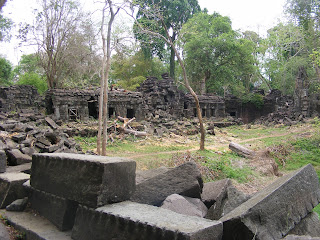I visited Cambodia with an old university friend, Christopher, who has travelled extensively in the region. A 24-hour flight took me to Singapore where I spent a night with cousins Harry and Claire Taylor. Chris and I met the next day at the classic Raffles Hotel, and flew on to Siem Reap in north-western Cambodia. We stayed in a delightful hotel which was almost empty, it now being low season - hot and steamy and threatening the start of the rains.
Temples 1
Angkor Wat lies 20 minutes north of Siem Reap by tuktuk (motorcycle taxi.)
It was the centre of the Angkorean Empire which flourished more or less from 802 to 1431 AD, extending at its zenith to much of Indo-China and parts of Thailand. Angkor Wat (temple) itself, dating basically from the C12th, is the largest religious complex in the world and a UNESCO world heritage site.

It is mainly the work of two kings, Suryavarman II and Jayavarman VII, but the earliest surviving temples in the area date back several centuries further. Just north of the temple is the old walled city of Angkor Thom, approx 3 km square! This still contains a few temples and the ruins of the royal palace complex, but most of the city would have been constructed of wood so nothing remains and the forest has flowed back in. No doubt much more can be learnt from archaeological digs across the city but as a tourist one is directed to the enormous sandstone ruins which do remain. We spent over a week here in total, visiting the ruins in the immediate vicinity and going further afield on day excursions.
The earliest temple which we saw – Baksei Chamkrong – dates from the C9th.

It is Hindu, as were all the dedications up to (effectively) the reign of Jayavarman VII, who followed his short-lived father in being a Bhuddist. After his death there was a Hindu reaction and a lot of Bhuddist iconry was destroyed or defaced.
The temples have also, of course, suffered extensive looting over the years, or simply collapsed. Angkor Wat is in extraordinarily good repair, although some restoration has been necessary. Within Angkor Thom is a temple called the Bayon, constructed by Jayavarman VII and containing numerous towers with multiple faces on them, possibly dedicated to Bhudda but apparently portraits of the king himself.
 There is a naval battle with the ocean full of fish and crocodiles, as well as scenes of city life, hunting etc.
We went up to the temple of Preah Vihear on the Thai border.
There is a naval battle with the ocean full of fish and crocodiles, as well as scenes of city life, hunting etc.
We went up to the temple of Preah Vihear on the Thai border.  In fact it was part of Thailand for a couple of centuries but recovered by the French when they colonised Indo-China in the C19th. Thailand seized it again in the 60s, leading to a brief war. The International Court of Justice eventually gave it back to Cambodia. As a result it has a strong (if not very convincing) army presence. The Thai border is only half a mile away.
In fact it was part of Thailand for a couple of centuries but recovered by the French when they colonised Indo-China in the C19th. Thailand seized it again in the 60s, leading to a brief war. The International Court of Justice eventually gave it back to Cambodia. As a result it has a strong (if not very convincing) army presence. The Thai border is only half a mile away.  We also went to Banteay Srei.
We also went to Banteay Srei.  Built by a senior minister in the C10th, it is smaller than the royal temples but beautifully carved.
Built by a senior minister in the C10th, it is smaller than the royal temples but beautifully carved.  The harder stone used not only meant that the carving could be finer, but also that it is better preserved over 1,000 years later!
The harder stone used not only meant that the carving could be finer, but also that it is better preserved over 1,000 years later! 
 It is amazing what the carvers managed to do with bronze tools. It is thought that the stones were polished by rubbing them against their neighbours to get the very tight fit. No mortar was used, although apparently a vegetable glue assisted in the construction process. Another remarkable feature is that the Angkoreans never discovered the arch, which is one reason the temples have fallen down. Also they were not always good at foundations, and in later years (2nd half of the C12th) they became lazy about overlapping the courses of stones, making the walls much weaker.
It is amazing what the carvers managed to do with bronze tools. It is thought that the stones were polished by rubbing them against their neighbours to get the very tight fit. No mortar was used, although apparently a vegetable glue assisted in the construction process. Another remarkable feature is that the Angkoreans never discovered the arch, which is one reason the temples have fallen down. Also they were not always good at foundations, and in later years (2nd half of the C12th) they became lazy about overlapping the courses of stones, making the walls much weaker.























